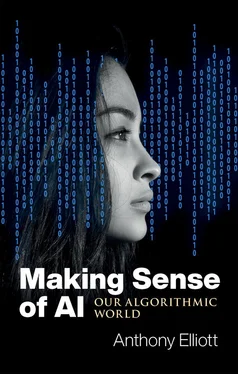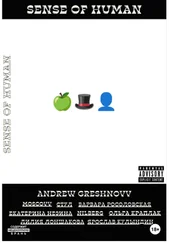Second, we may note that some of these formulations of AI seem to raise more questions than they can reasonably hope to answer. On several of these definitions, there is a direct equation between machine intelligence and human intelligence, but it is not clear whether this addresses only instrumental forms of (mathematical) reasoning or emotional intelligence. What of affect, passion and desire? Is intelligence the same as consciousness? Can non-human objects have intelligence? What happens to the body in equating machine and human intelligence? The human body is arguably the most palpable way in which we experience the world; it is the flesh and blood of human intelligence. The same is not true of machines with faces, and it is fair to say that all of the formulations on this list displace the complexity of the human body. These definitions are, in short, remorselessly abstract, indifferent to different forms of intelligence as well as detached from the whole human business of emotion, affect and interpersonal bonds.
Third, we can note that some of these formulations are sanguine, others ambiguously so, and some altogether over-estimate the capabilities of AI today and in the near future. An interesting feature of many of these formulations is that they tend to flatten AI into a monolithic entity. Today, AI can be a virtual personal assistant, a self-driving car, a robot, a smart lift or a drone. But it is not obvious that many of these formulations can easily cope with these gradations or differentiations of machine intelligence. A smart elevator using AI to manage the flow of demand in an office building based on data collected from daily usage, for example, is essentially goal-orientated and single in technological objective. It is an example of weak or narrow AI , where machine intelligence can only do what it is programmed to do, based on a very limited range of contexts and parameters. Examples of narrow AI range from Google Search to facial recognition software to Apple’s Siri, and these are all quite basic kinds of automated machine intelligence. They have been programmed to perform a single task well yet cannot switch to perform other types of tasks – or, at least, not without considerable further labour performed by engineers and computer scientists. On the other hand, there are more sophisticated forms of AI. Deep AI , or what is termed artificial general intelligence , is an advanced form of self-learning machine intelligence seeking to replicate human intelligence. Unlike narrow AI technologies, deep AI combines insights from different fields of activity, performs multiple tasks of intelligence and displays considerable flexibility and dexterity. Deep AI entails the harnessing of massive computational processing power – for instance, the Summit supercomputer, which, in performing 200 million billion calculations per second, is among the fastest computers in the world – to machine learning algorithms. Arguably one of the best operational examples of deep AI is IBM’s Watson, a system which combines supercomputing with deep learning algorithms: such algorithms are designed to optimize their performance against specified data-processing criteria (such as speech or facial recognition, or medical diagnosis) through self-adjusting the thresholds of what is relevant or irrelevant in the data under analysis. Another AI variant is that of superintelligence , which doesn’t exist yet, but is forecast by many specialists to involve a fully fledged machine intelligence which outstrips human intelligence in every domain, including both cognitive reasoning and social skills. Superintelligence has long been the preserve of Hollywood science fiction, and the personalized AI system of Samantha in the film Her is a signal example. (We will turn to consider technological advances related to superintelligence in more detail in Chapter 8.)
One of the problems of current debate is that there is a lot of hype, a lot of misconceptions and too many overblown claims about AI. One way of reading AI against the grain is to avoid the specialist definitions circulating in the field and talk about resistances, disorders and the historical past instead. It is always useful to get a sense of how a specialist discourse is approached by those outside of its representative institutions, and similarly it helps to look at the prehistory of an emergent technology. This line between the ‘official’ and the ‘unofficial’ version of AI is not always easy to cross, but I want to focus briefly on considering aspects of the prehistory of AI – in order to better grasp the constitution of the whole discourse of AI. That is to say, I want to focus on the function of ideas within and around AI – including the aspirations, objectives and dreams of technologists – in order to better situate today’s technological realities as well as its manifold distortions. In other words, my aim here is to return AI to its own displaced history.
An objection to the glossy image presented by various tech companies that AI has only recently arrived, and arrived fully formed, is that machine intelligence and mechanical automatons are, in fact, historical through and through. Those advocating the technological hype of our times may not wish to be embroiled in trawling through the histories and counter-histories of various technologies, but expanding the historical boundaries of the discourse of AI by bringing back into consideration those developments banished to the background and left out of the official narrative is essential to combating the idea that AI is a straightforward, linear story which runs roughly from the 1956 Dartmouth Conference to the present day. The developments that unite an otherwise disparate and apparently unconnected series of topics in the emergence of AI require us to go back to the eighth century bc, where automatons and robots crop up in Greek myths such as that of Talos of Crete. 4Or you have to go back to the ancient world of Mesopotamia, where Muslim polymath Ismail Ibn al-Razzaz al-Jazari invented automatic gates and automated doors driven by hydropower, whilst simultaneously penning his programmatic text, The Book of Knowledge of Ingenious Mechanical Devices . 5An alternative historical starting point might be the ancient philosophy of Aristotle, who wrote of artificial slaves in his foundational Politics . 6
Fast forward to the early modern period in Europe, where the landscape of automatons is still largely about dreaming but also where conflicts between human and machine intelligence become amenable to, and await, resolution. Early modern European thought in cooperation with scientific reason found its way towards such conflict resolution under the twin banners of calculation and mechanics . The French philosopher, mathematician and scientist René Descartes compared the bodies of animals to complex machines. In the political thought of Thomas Hobbes, a mechanical theory of cognition stood for the human territory over which reason extended. In the practice of French mathematician and inventor Blaise Pascal, arithmetical calculations stood for the feasibility and ultimate triumph of the theory of probability – as this prodigious physicist and Catholic theologian worked obsessively to build mechanical prototypes and calculating machines. Fast forward again some centuries and we find writers and artists alike viewing a society leaning solely on human attributes or natural impulses with considerable suspicion. Throughout the modern era, from Mary Shelley’s Frankenstein to Karel Čapek’s Rossum’s Universal Robots , reality was to be shaped, thought about and interpreted with reference to automatons, cyborgs and androids. At the dawn of the twentieth century, the dream of automated machines was brought finally and firmly inside the territory where empirical testing is done, most notably with a tide-predicting mechanical computer – commonly known as Old Brass Brains – developed by E. G. Fischer and Rolin Harris. 7The world had, at long last, shifted away from the ‘natural order of things’ towards something altogether more magical: the ‘artificial order of mechanical brains’.
Читать дальше

![Джейн Остин - Sense and Sensibility [С англо-русским словарем]](/books/26612/dzhejn-ostin-sense-and-sensibility-s-anglo-thumb.webp)










